After guiding Barcelona to their second treble ever, in their first season under Luis Enrique, Xavier Hernández bid farewell to his boyhood club. Coming out from the club’s famed La Masia academy, Xavi used his graceful midfield presence and undeniably well-knit football understanding to bring glory to both Barcelona and Spain in his career. Calling time on his career at Barcelona, the Spanish midfield maestro headed to Qatar to play for Al Sadd SC after the 2014/15 season.
After completing his first spell at the Qatari club, serving four seasons as a player, Xavi was given the manager’s role immediately after his retirement by Al Sadd. Ever since then, Xavi and Al Sadd have been in everyone’s focus, as many football fans perceive Xavi’s spell at Al-Sadd to be his preparations of coming back to the Camp Nou as a manager in near future.
Hence, in this scout report , we will be doing a tactical analysis of how Al Sadd have been under Xavi so far. We will look at their build-up scheme, attacking traits and defensive tactics, which will let us know how Xavi is getting ready for his potential move to Barcelona soon.
Al Sadd’s build-up play
Xavi’s build-up philosophy at Al Sadd is possession-based, reflecting the system that he thrived under when he was a Barcelona player. Al-Sadd, under Xavi, have evolved to a possession-based side that love to dominate by keeping possession. During the 2019/20 Qatar Stars League, the side retained 63.8% possession per match, a figure well-above the league average.
During the build-up, Al Sadd like to build-up from the back, making sure every part of the pitch is occupied. Using positional coverage, they try to avoid losing the ball and enjoy longer spells of possession frequently. The build-up starts with a four-man backline inside their own half. By maintaining a four-man structure and playing short passes in close proximity, Al Sadd try to obtain plenty of options to advance forward. The central defenders provide them an option to advance from the central route via midfielders, whereas the full-backs in a four-man system provide the width to their build-up.
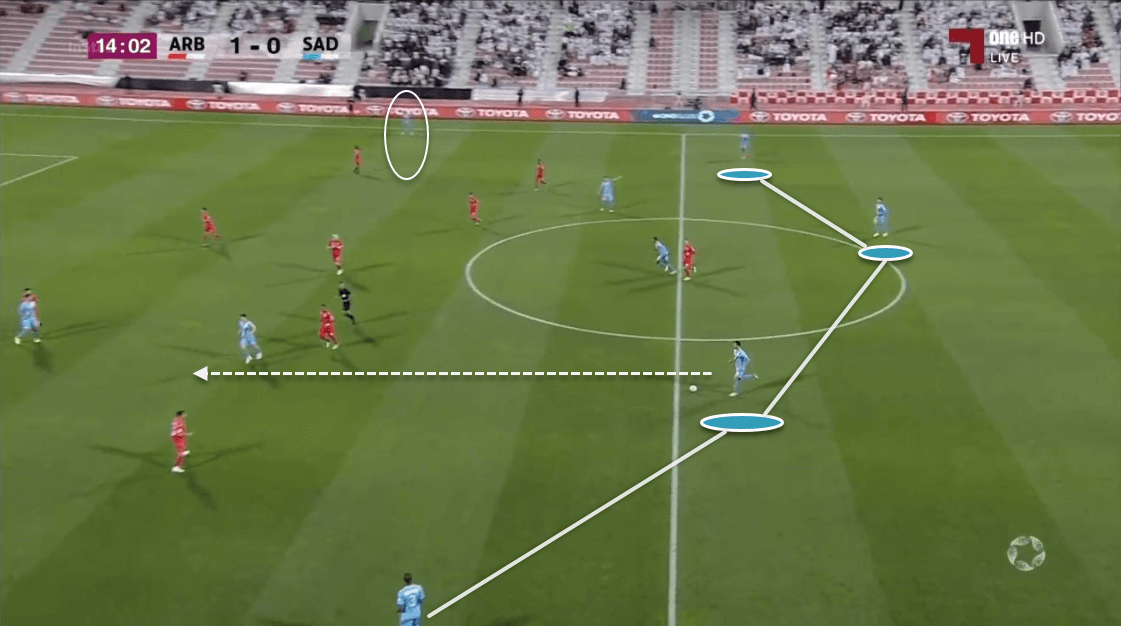
Generally, the centre-backs are given a ball-playing role, as they’re made comfortable with the ball. The centre-backs are often seen using progressive passes to break multiple opposition lines from the back, as we can see in the instance above. Al Sadd average 79.14 progressive passes per 90, the highest figure in the league, due to this very approach. This approach has been successful for them, as 88% of their total progressive passes have been successful.
Similarly, Woo-Young Jung, the centre-back capable of playing in a defensive midfield double-pivot is a vital player in the build-up. His ability of spotting runs to make progressive passes directly to the final third makes him one of the highest passers to the final third in the league, second only to Gabi, his teammate. Suitable to Xavi’s emphasis on possession to dominate the game and set-out attacks, Jung and Gabi are the most prolific and efficient passers in the team, with 90% and 93% pass completion rate. Overall, this approach of building-up to advance seems successful in Al-Sadd’s regard and it’s quite clear that they’ve somehow mastered this style of play. Al-Sadd players complete 81% of their total forward passes, making them the most efficient forward-passing team in the league.
Positional dynamism and its influence in the build-up
Xavi has taken a multiple set of approaches when fielding this Al Sadd side. The most-frequently used formation is 4-2-3-1, with Woo-Young Jung and former Atlético Madrid man Gabi as the double pivot. Boualem Khouki and Tarek Salman complete the centre-back duo when this approach is taken. When this formation is used, the regular build-up strategy, like we analysed above, is taken.
However, in the presence of players who can play in multiple positions, Xavi has been able to provide his side with positional flexibility. Al Sadd can line-up in a 4-3-3, ultimately positioning in a 4-3-2-1 depending on the opposition they’re facing. When building-up in this formation, Al Sadd prefer to make use of their central defensive midfielder to create an extra passing option and beat the opposition’s first line of press. Similarly, this approach is frequent while making transitions from defence to attack.
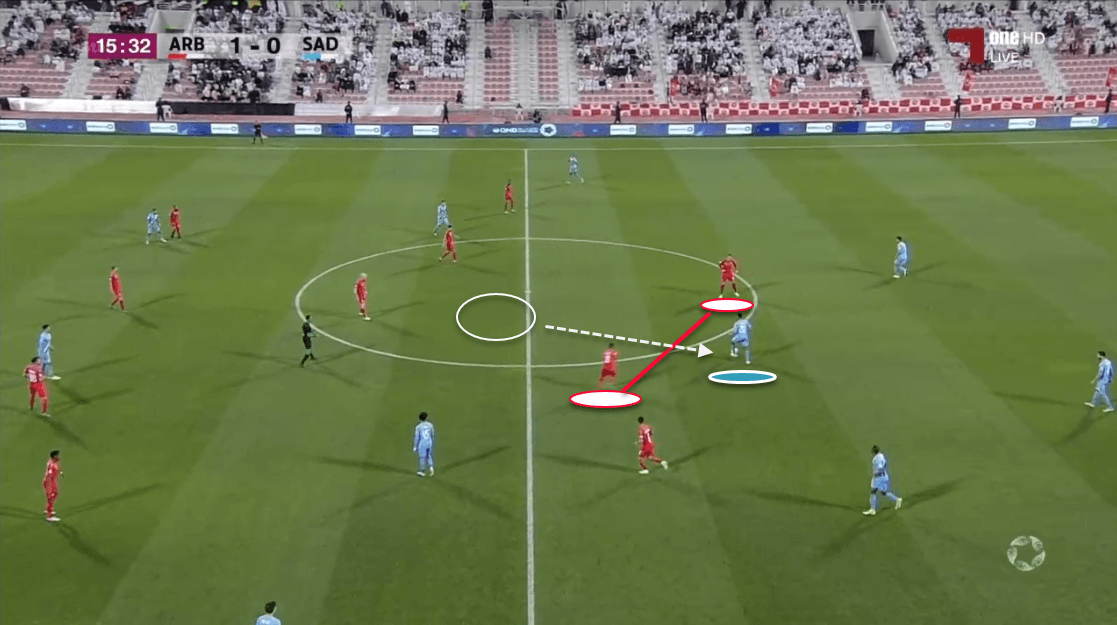
In this instance, Salem Al-Hajri, the central defensive midfielder is seen dropping deep as compared to his corresponding midfield partners Gabi and Tae Hee Nam to shorten the passing distance between him and the centre-back. When he receives the ball, he has multiple options in front of him. He can create a link-up system with his midfield partners, in presence of a deep-lying playmaker like Gabi, or choose to pass wide towards the run-making full-backs. The role of full-backs in transforming a build-up into attack is vital as well, which we’ll discuss as the analysis progresses.
Use of width to transform attacks
As mentioned above, Al Sadd prefer two approaches to get the ball into the final third: line-breaking passes direct into the box, or use of the width to stretch the opposition line and deploy the ball in the opposition 18-yard area. Al Sadd rely a lot on the latter approach, as the wide players are always apparent in transforming their gradual build-up into a lethal attack.
Making sure most areas of the pitch is covered, the positioning and movement of wide players is well organized in Xavi’s philosophy at Al Sadd. The full-backs and wingers coordinate well and provide width in the final third. Full-backs Pedro Miguel and Abdelkarim Hassan coordinate well with the wide forwards ahead, and despite playing in multiple formations, Al Sadd’s combination in wide areas remains consistent and lethal. Out of 482.97 passes that Al Sadd attempt per 90, 202.98 are lateral passes used to shift plays in the wide areas. An 88% success rate in the lateral pass attempts show that Al Sadd are quite comfortable and effective in switching play and using the width.
When the full-backs are seen tucking in and making half-space runs, the wingers place themselves in the wide side of the pitch. When Miguel and Hassan make inside runs, wingers like Akram Afif and Hasan Al-Haydos play a supporting role, playing them passes to create space for them, as we can see below:
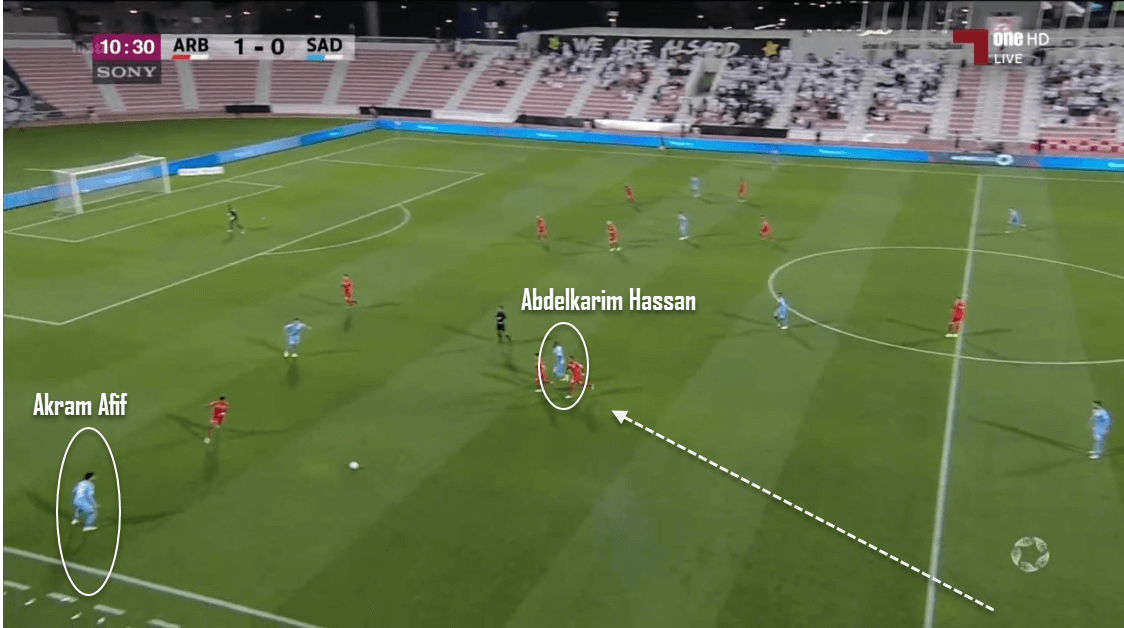
Similarly, when the wingers are not inverted while progressing the attack, they place themselves wide. When this happens, the wingers are given the freedom to make runs and cut inside. Generally, Akram Afif’s cut-in runs from the left wing show this type of character.
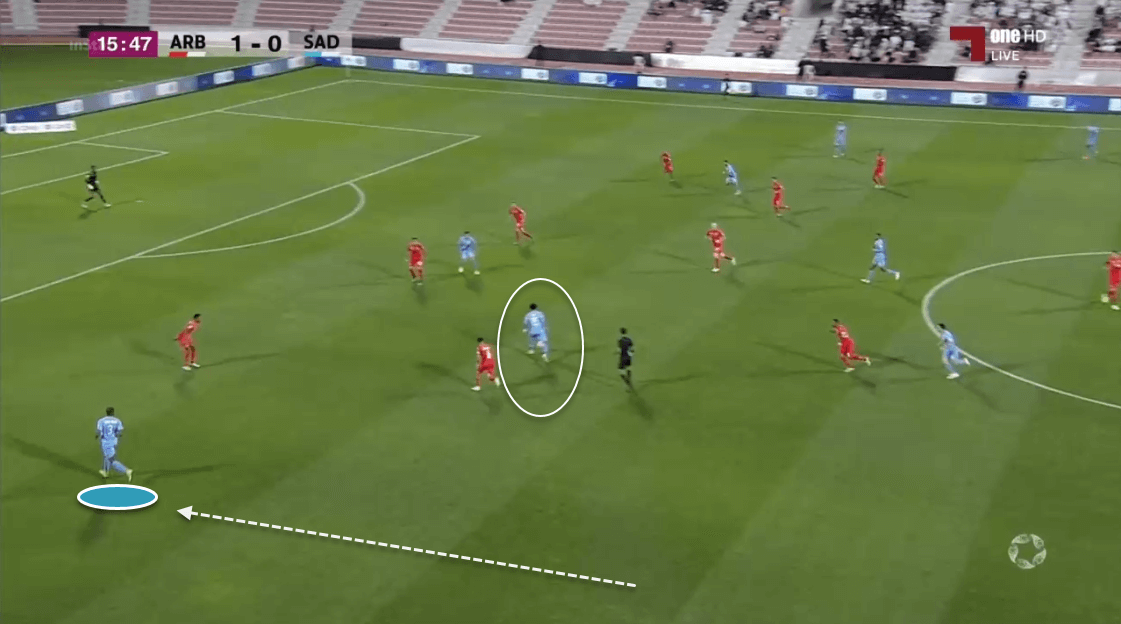
Akram Afif generally places himself wide on the pitch, cutting inside when he gets the ball. Hassan makes up for his central movement by occupying his wide position, as we can see above. Xavi’s approach of using players like Marco Fabian, Akram Afif and Hassan Al-Haydos to contribute in the box relies on this type of movement. In particular, Afif’s ability to play from both the right wing and the left, makes Xavi able to have enough players that can further the build-up into attacks from the wide areas.
This type of freedom to cut inside has benefitted both Afif and Al Sadd in general. Most of Al Sadd’s shots in the 2019/20 Qatar Stars League have come from the left side, with Afif’s moves involved in the shot-taking build-up heavily. We will discuss Al Sadd’s attacking effectiveness and tactical flashpoints in the next section.
Al Sadd: The most prolific attackers in Qatar
After looking at the ways Al Sadd build-up, let’s look at Al Sadd’s end product in attack. Al Sadd are very good in creating chances in front of goal because of their alternatives of using the width as well as abilities of proceeding from the centre. Al Sadd’s cumulative xG in Qatar Stars League 2019/20 equals 42.32, scoring 44 goals in 17 matches so far. This makes them the most effective attacking side in Qatar, as the average league xG is 23.25 and the second-placed side in terms of cumulative xG, Al Rayyan have managed a cumulative xG of just 23.54.
Al Sadd’s use of 4-3-2-1 and 4-2-3-1 enables them to have a target man upfront, who can have the freedom to roam around the box. Similarly, the lone forward is generally relieved of his defensive duties, hence making Al Sadd’s presence inside the box heavy. The two-man or three-man setup behind the striker makes sure Baghdad Bounedjah gets enough supply inside the box, both from the wide and the middle.
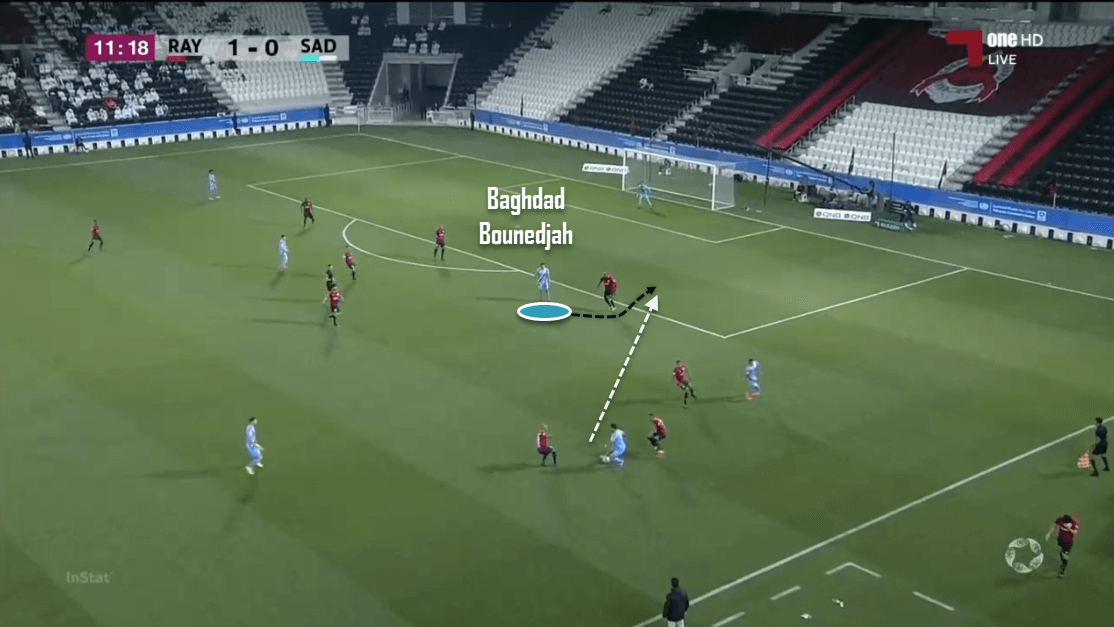
In the instant shown above, Bounedjah is placing himself just outside of the box. As the midfielder prepares to beat his man by executing a turn, he makes a run around the defender to meet his man. Similarly, we can see support arriving for him towards the left side, ultimately increasing the number of touches that Al Sadd take inside the box. Throughout the 2019/20 season, Al Sadd took 26.40 touches inside the box per 90, surpassing the league average of 14.50 touches per 90. Similarly, Al Sadd’s deep completions average 15.97 per 90, way more than the league average of 7.77 per 90.
In addition, their approach from the wide is also focused on targeting Bounedjah’s freedom and space. Players like Hassan, Afif, Al-Haydos and Fabian deploy the ball from outside wide, targeting the striker in space. Similarly, Bounedjah too uses his freedom to find spaces behind defences and get in spaces left from the defenders drawn by his teammates.
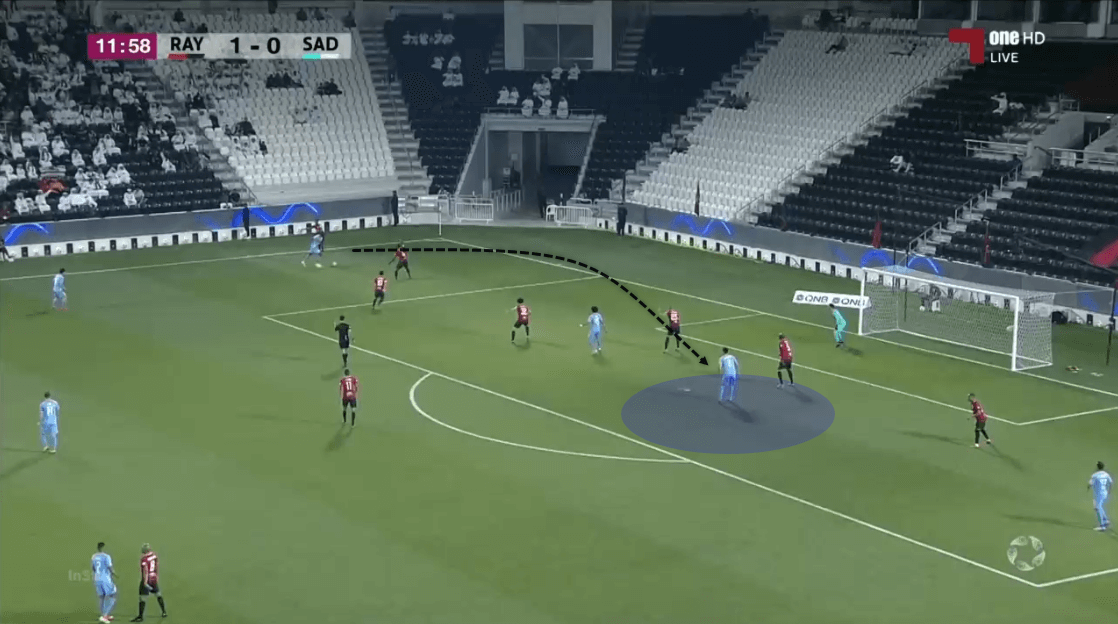
As Adelkarim Hassan is carrying the ball and prepares to cross, Akram Afif gets inside to draw defenders and relieves Bounedjah in space, as shown in the above instance. Most of these passes resulting in shots come from the left with the presence of Afif and Hassan. Al Sadd’s shot-map for the 2019/20 season makes this further evident, as we can see the shots taken are denser towards the left.
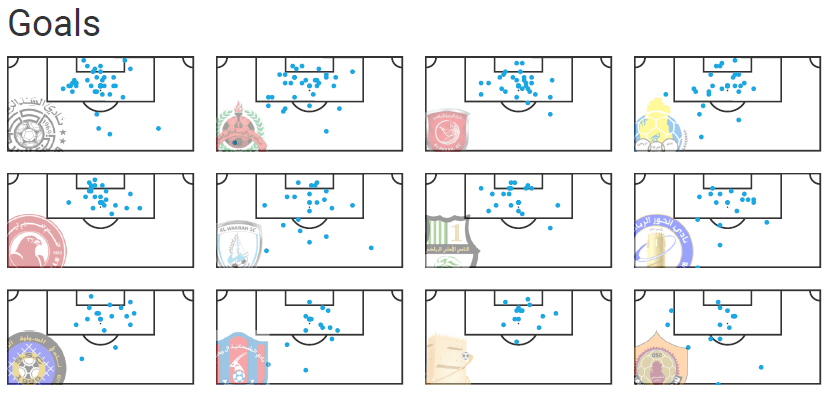
Similarly, when the build-up is made using a network of short passes through the midfield, through-balls are commonly played to one of the forward players. In the instance below, Bounedjah is seen making a run exploiting the space between two centre-backs, demanding the ball from Pedro Miguel.
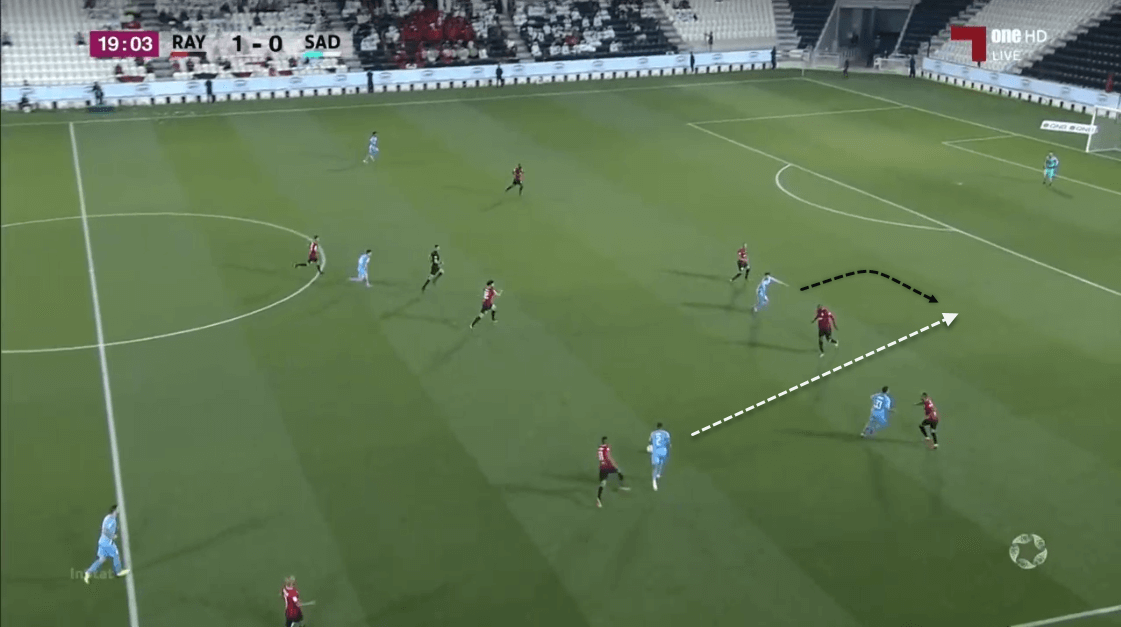
In the next instance, Bounedjah successfully executes the move and receives the ball, leaving the defenders behind. He makes a lethal run, resulting in a shot on goal. In this manner, Al Sadd are regularly able to make use of their tactical rundown to unlock defences in the league.
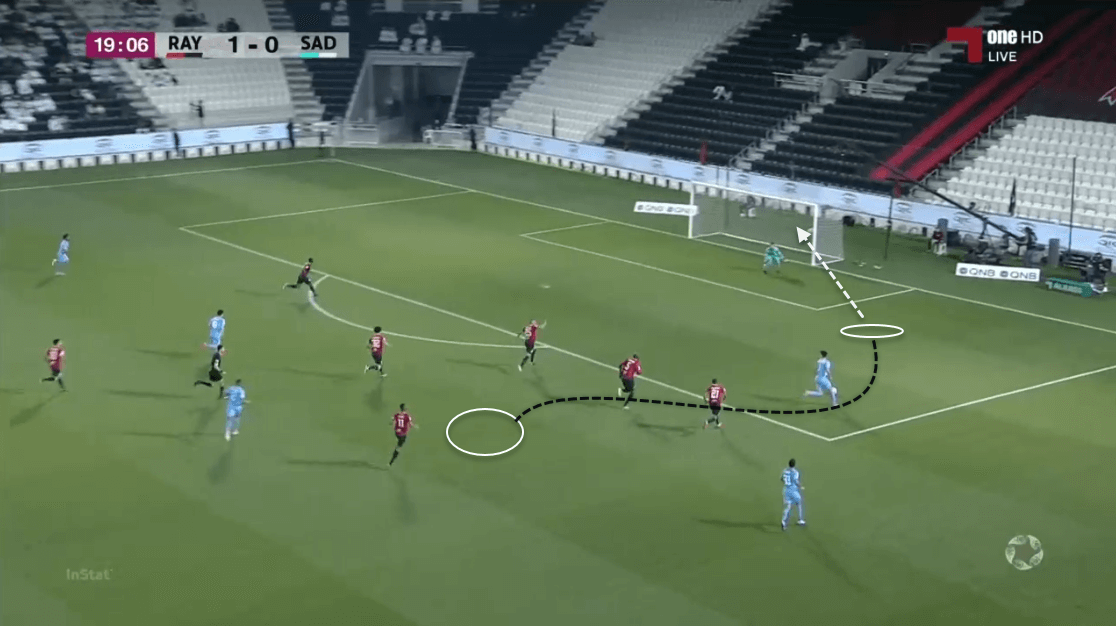
Among the attackers, Baghdad Bounedjah has scored 13 goals, underperforming an xG of 15.03, per Wyscout. Al Sadd might look for an upgrade, considering options that possess better finishing in front of goal than Bounedjah. Similarly, Akram Afif stands out with 12 goals and 8 assists, overperforming both xG and xA, while making the highest number of key-passes and deep completions.
Hence, in the attacking department, Xavi’s Al Sadd are so far so good, dominating the league with their attack. Similarly, the philosophy that he has brought to Al Sadd matches the philosophy that Barcelona adopt, hence hinting that preparations for Catalonia are certainly under way.
Al Sadd’s pressing and defensive structure
Since Al-Sadd are a possession-based side, they’re rarely found sitting back and defending deep. However, to counter the opposition side when they’re inside Al Sadd’s own half, the side decides to opt for a 4-3-2 shape, adopting a mobile-pressing structure while following a similar formation when they’re in possession.
By mobile-pressing, we can say the nearest man towards the ball gets withdrawn to press, leaving his position. To make sure the area is covered, another player nearby the void fills it, while breaking the passing channels and making sure the structure remains rigid for Al Sadd
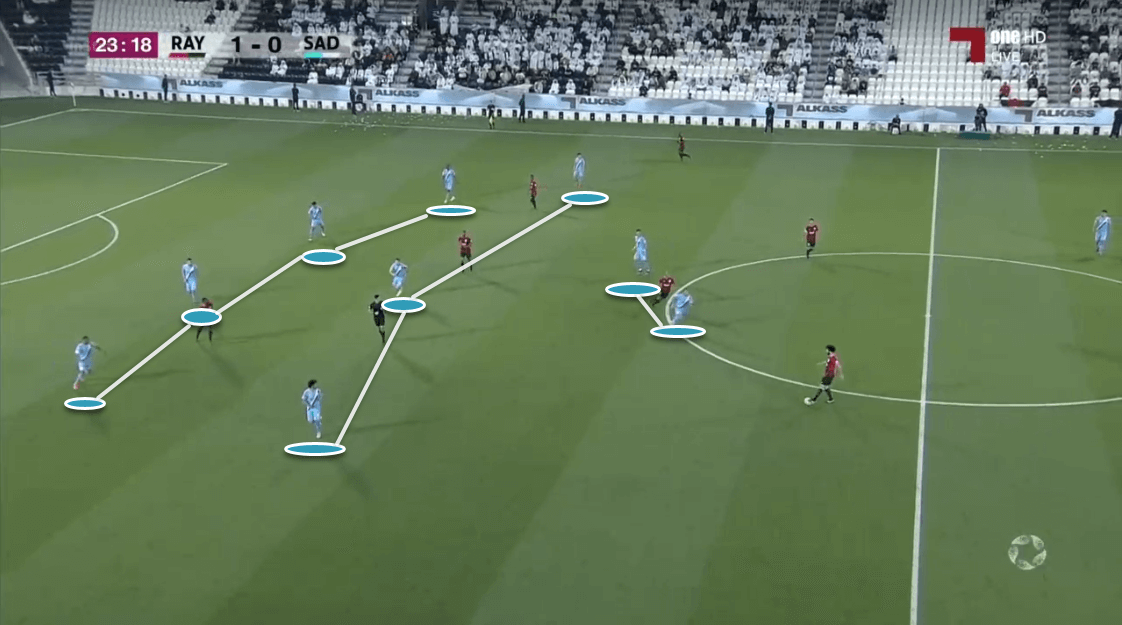
As we can see in the picture above, Tae Hee Nam, the left player in the forward two, escapes out of his central role to press his corresponding player. His position is then occupied by Gabi, whose position is then taken by another player. This maintains the 4-3-2, at the same time makes the press functional. Another thing to notice here is that the striker is completely relieved of his defending duties in Al Sadd’s own half. Since Al Sadd don’t prefer to press too high, Bounedjah is generally not obliged to contribute towards the team’s press. The scenario, however, becomes different during the counter-pressing.
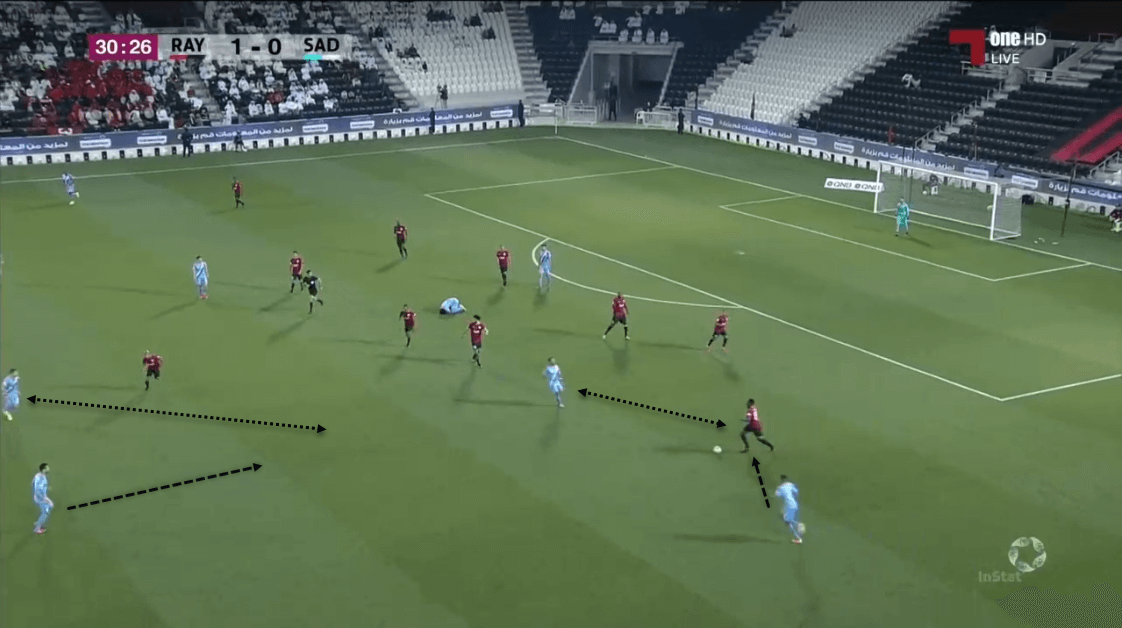
As we can see here, Al Sadd’s attack breaks down and the opposition are looking to make a quick transition from the middle. In these scenarios, Al Sadd try to create numerical superiority around the players that lie close to the ball. As we can see, two players are arriving towards the opposition ball-carrier, putting him under pressure with a 2v1 situation. Similarly, the other two midfielders are coming in to close down the passing channel towards the other side of the pitch, also guarding the potential receiver. Gabi, in these situations, has stood out for Al Sadd, as he boasts the most number of defensive duels won and recoveries made off loose balls. In this instance as well, Gabi recovers the ball easily, hence bringing the ball back to Al Sadd’s own comfort.
Al Sadd’s defensive woes
Al Sadd currently lie third in the Qatar Stars League table, despite leading most of the team attacking metrics in the league. Al Sadd’s inconsistent defence, getting caught frequently, individual errors and aerial struggles have made Al-Sadd’s defending a set-back. Despite having an xGA of 19.22, Xavi’s side have been relatively poorer in defence. League leaders Al Rayyan and Al-Duhail have only conceded 14, as compared to Al Sadd’s 27.
There were two major factors that made Al Sadd suffer. First, Al Sadd were easily vulnerable in the space behind their defensive line. Al Sadd’s preference of staying close to each other to maintain passing tempo somehow backfired in their defending as any team that got the ball past their defensive line from the middle shook Al Sadd completely.
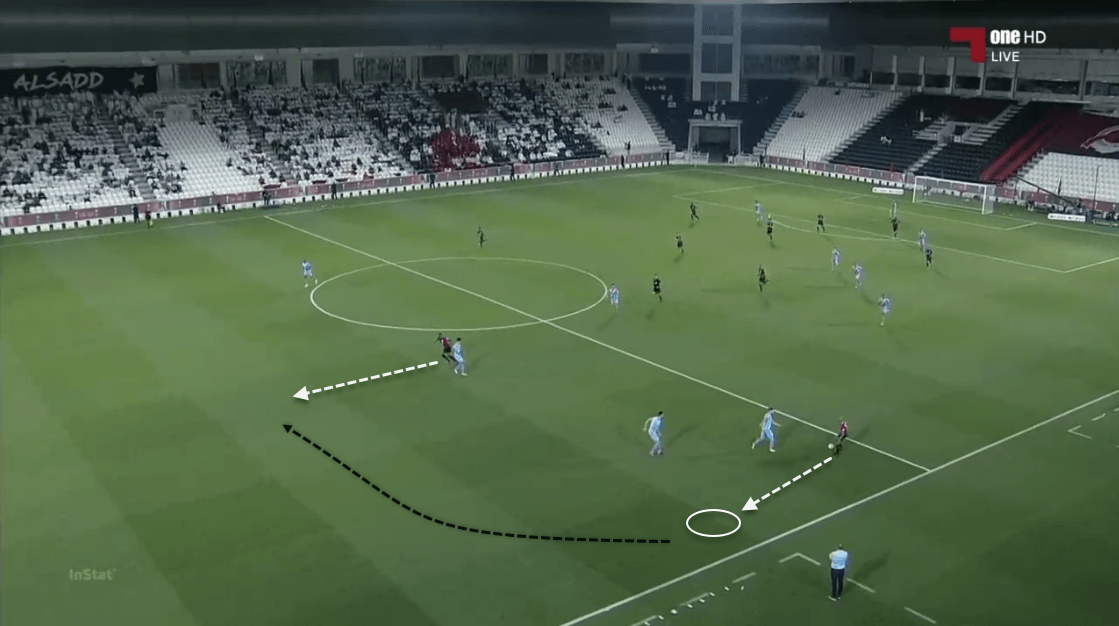
In the instant shown above, the opposition recovers the ball and plays it out to the wide player, who is seen with the ball here. In addition, he travels further and spots the run towards the middle. The pass is successfully executed, hence creating a 1v1 opportunity for the forward. Similarly, this brings us to Al Sadd’s another problem, failing to transit from attack to defence. The instance also shows a lack of players that are defending from central areas. Al Sadd concede the second fewest shots in the league (8.09 per 90) yet have conceded more than six sides in the league.
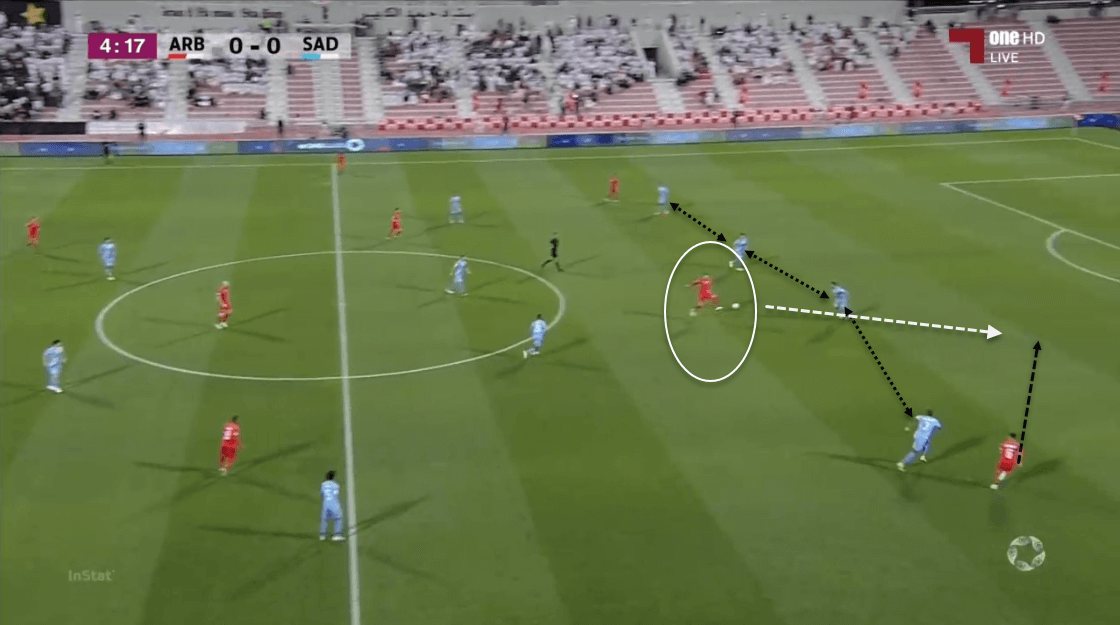
In addition, during their regular defending procedure as well, Al Sadd’s vulnerability from central spaces places them in dangerous defensive situations. Like we can see in the instance above, the centre-back in front of the ball-carrier commits too soon, allowing the attacker to take advantage of the defender’s stiffness to pass the ball to the run-making player, coming inside just behind the defensive line. This move ultimately ends with a shot on goal, and Al Sadd were yet again exposed not being able to cover their spaces behind the rigid line.
While the rigid line definitely limits chances of opposition penetrating them, but when they do, it becomes very dangerous. Due to this very reason, goalkeeper Saad Al Sheeb often finds himself one-on-one against the attacker as the defensive line is beaten already. As a result, Al Sadd are only able to 16% of the total shots they concede, ultimately conceding more than they should. Similarly, teams expose this space with aerial balls as well, and Al Sadd’s stats are not so good defending aerial balls. Mostly, diagonal balls are used to expose the space behind left-backs, and Al Sadd only win 31% of their total aerial duels. Al Sadd’s vulnerability in this crucial space makes it almost impossible for them to win the ball back, which becomes further evident when we look at their 30.66 recoveries in own third per 90 and 30.09 interceptions per 90, lowest compared to other Qatari sides.
Despite having one of the best attacking force in all of Middle East, Al Sadd’s defensive woes have limited them to the third position in Qatar Stars League this season. Xavi will certainly be looking to improve this next season, to go for the title and re-introduce Al Sadd’s continental dominance.
For Barcelona fans, Xavi is a certain managerial candidate, who is expected to replace Quique Setien after the Basque’s spell at the Camp Nou is over. After succumbing in front of Real Madrid in the league, Barcelona expect Xavi to develop more than ever to make an appointment soon. Adapting his Al Sadd side into the system that Barcelona have in their DNA, Xavi certainly has started preparing himself for the job, also making Al Sadd a well-structured side. Xavi will certainly look to sign some more players and work properly with Santi Cazorla next season.
With defensive tweaks and further tactical improvements, Xavi will be looking to make the most out of the resources he has at Al Sadd. Xavi’s first season as manager has certainly shown some optimism, and as we looked through this article, the preparation for Barcelona has started, yet things need to be done for it to go well at the Camp Nou.

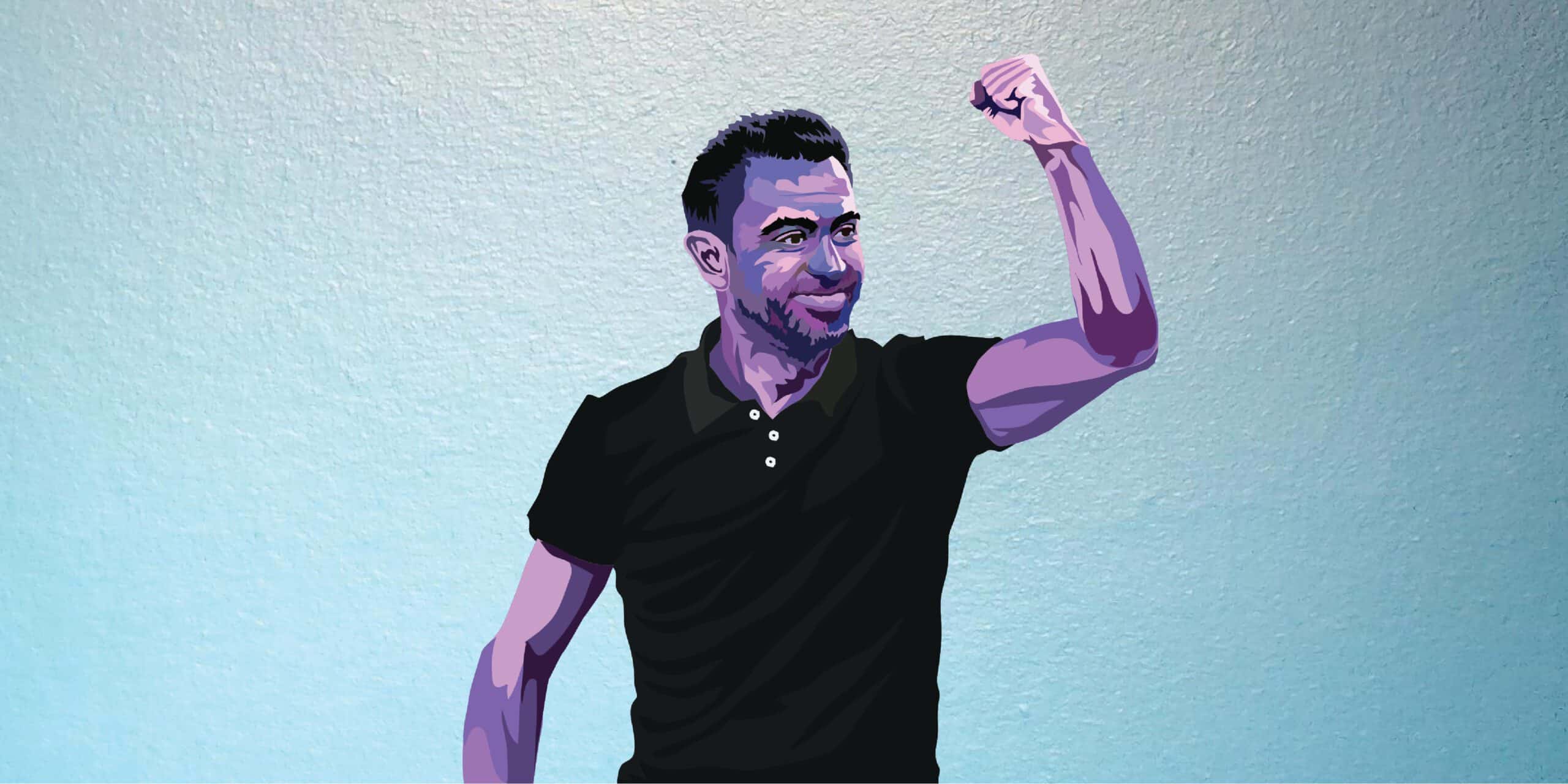




Comments